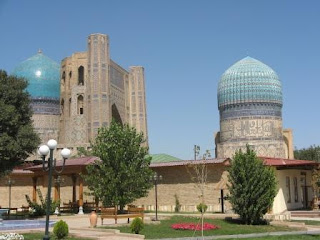Although the road we took to Samarkand was more sandy than golden, this part of James Elroy Flecker's poetry captures a bit our travel mood:
...
We travel not for trafficking alone;
By hotter winds our fiery hearts are fanned:
For lust of knowing what should not be known,
We take the Golden Road to Samarkand.
...
After checking in to the Malika Prime, we started our discovery of Samarkand that does not live up to the promise of its name and the feelings it triggers in all of us. Nowadays Samarkand is a modern city with some beautiful historic sights scattered in between.
First we found a souvenir shop cum post office cum money change. The highest banknote is 1,000 sum (round about 0,30 Euro), so whenever you change money, you have to count to some really high numbers for some time (once we nearly cracked the million).

Me & Inka counting our wealth
The Registan is a main square that is surrounded on three sides by medressas that date from different times. The first was built by Ulughbek in the 16th century, the other two were built later to join the majestic of the first one. Each of them features unique decorations. Today all are converted to workshops, galeries and souvenir shops. The biennal music festival takes place on the Registan, so they block the great view with an audience seating area.

Registan with Tilla-Kari Medressa

Decor of Sher Don medressa (same ornament is also on the two hundred sum note)
From behind the Registan leads a pedestrian boulevard to the other sights. Only battery buses are allowed to go here. The boulevard is lined with souvenir shops that lead up to the Bibi-Khanyam Mosque. Only the entrance portal and the garden are restaurated, the mosque itself has many cracks and only the dome was reconstructed. The mosque faced a constant problem of buildings of that time: the architectural techniques could not live up to the wishes of Amir Timur. They faltered soon after their construction.

On the opposite hill is spread the Shah-i-Zinda ("City of the Living King") - an astonishing ensemble of mausoleos of the a cousin of the prophet Mohammed, famous persons and the women of the royal family. Especially the mausoleos of the last are very beautiful. Adjoining is the contemporary cemetary that includes the grave of President Karimov's mother. Many tombstone feature a picture of the deceased which is not common in Islam.

Shah-i-Zinda
The road leads further to the observatory of Ulughbek who did not only rule the country, but was also known as scientist. Unfortunately, his son regarded science as whitchcraft, beheaded his father and destroyed all his astronomy instruments. Only the lower part of the sextant remained hidden for centuries before it was rediscovered.

Ulughbek's sextant
The magic of Samarkand unfolds at night when all the sights are nicely lit. So we returned to Gur Emir to take some wonderful pictures. At this sight, Amir Timur, Ulughbek and some other important persons are buried. Amir Timur had already commissioned his grave in Shakhrisabz, but he died on an expedition to China and the mountain pass was covered with snow, so he was put to rest in Samarkand.

Gur Emir
On our last day, we took a taxi to the Koni Ghil Meros paper manufactory. The paper is produced from the bark of the mulberry tree. They cut the bark off, take the inner soft part, mix it water, stomp it for several hours, sieve it as a sheet, dry it, press it and smooth it. We got some detailed explanation on how it works.

cutting of the bark of the mulberry tree

innovative water supply
From there we continued to the bazaar where we bought something to eat for the train ride in the evening, vodka to take home and souvenirs.

In the evening, we left Samarkand by train to Tashkent.




No comments:
Post a Comment